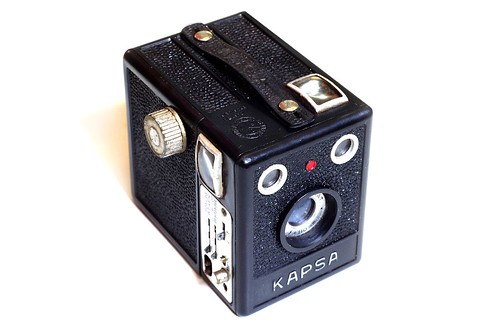Kapsa: Brazil's Secret Camera
A couple of weeks ago I was given an old, 120 camera spay painted entirely gold; don't ask why. But anyway, I cleaned it all up with white spirit and washing up liquid and did a pretty good job of getting all the paint off. It looked like one of the later Kodak Brownies, but had a little logo of some kind and the words "INDUSTRIA BRASILEIRA": Made in Brazil on the top. It was getting more intriguing. On the front, under the lens, it had big sliver letters spelling out "KAPSA" (Brazilians seem to like their capital letters). So I did a little Google search and came up with very little; things like the "Korean American Pharmacy Student Association" and an Arabian dish made from chicken and rice. With the general search being a bitter disappointment, I moved on to other things. I had a gander at Flickr and found a handful of people who still use them.
I thought to myself "that can't be all there is on the internet!" and had another look at the camera. Then I noticed that on the metal bit around the lens was the peculiar word "VASCROMAT", again in block caps. Crossing my fingers, hopping I found something relevant. It was a hollow victory when the 75 results came back 0.49 seconds later; they were all in Portuguese! And most were just telling you how much they were worth. I did manage to find the most important information. The shutter speed. It is apparently 1/100. Which means that I have to use 160 ISO film. Which unfortunately does not want to be found easily. So rather than wasting my life hunting film in the vast planes of eCommerce websites, I decided to use 400 ISO that was stopped down to 200 with an ND 2 filter.
The camera has a little window on the inside as a mask for the incoming light. It it no bigger than an inch square, so I could just get some ND lighting gel. You can buy a whole sheet for the same price as a regular glass filter, but I only want a tiny square. That is where a little help from my friends come is. I know a woman who is a TV production designer and she said that she could have a word with a lighting technician who would have some ND gels. So until then I'm stuck with 400 ISO colour negative film. I did read about red scaling colour film some time ago and remembers something about you having to adjust it exposure by a couple of stops. I looked it up again and indeed, the celluloid is ND 2-3 so I just did that with some 35mm with the canister blue-taced in upside down where the new spool would normally go and taped the leader to the take up spool and I'm looking forward to seeing the results.
 Image by Rodrigo Moraes
Image by Rodrigo Moraes
I thought to myself "that can't be all there is on the internet!" and had another look at the camera. Then I noticed that on the metal bit around the lens was the peculiar word "VASCROMAT", again in block caps. Crossing my fingers, hopping I found something relevant. It was a hollow victory when the 75 results came back 0.49 seconds later; they were all in Portuguese! And most were just telling you how much they were worth. I did manage to find the most important information. The shutter speed. It is apparently 1/100. Which means that I have to use 160 ISO film. Which unfortunately does not want to be found easily. So rather than wasting my life hunting film in the vast planes of eCommerce websites, I decided to use 400 ISO that was stopped down to 200 with an ND 2 filter.
The camera has a little window on the inside as a mask for the incoming light. It it no bigger than an inch square, so I could just get some ND lighting gel. You can buy a whole sheet for the same price as a regular glass filter, but I only want a tiny square. That is where a little help from my friends come is. I know a woman who is a TV production designer and she said that she could have a word with a lighting technician who would have some ND gels. So until then I'm stuck with 400 ISO colour negative film. I did read about red scaling colour film some time ago and remembers something about you having to adjust it exposure by a couple of stops. I looked it up again and indeed, the celluloid is ND 2-3 so I just did that with some 35mm with the canister blue-taced in upside down where the new spool would normally go and taped the leader to the take up spool and I'm looking forward to seeing the results.
 Image by Rodrigo Moraes
Image by Rodrigo Moraes


1 Comments:
Go to Flickr: search for Kapsa.
http://www.flickr.com/groups/kapsa
shuter: 1/100, B
f: 22, 16, 11
range: 1-2, 2-8, 8-infinite
This was a camera for schoolboys, while their parents were using Isolettes, Ikontas, Rolleis, etc.
Post a Comment
Subscribe to Post Comments [Atom]
<< Home